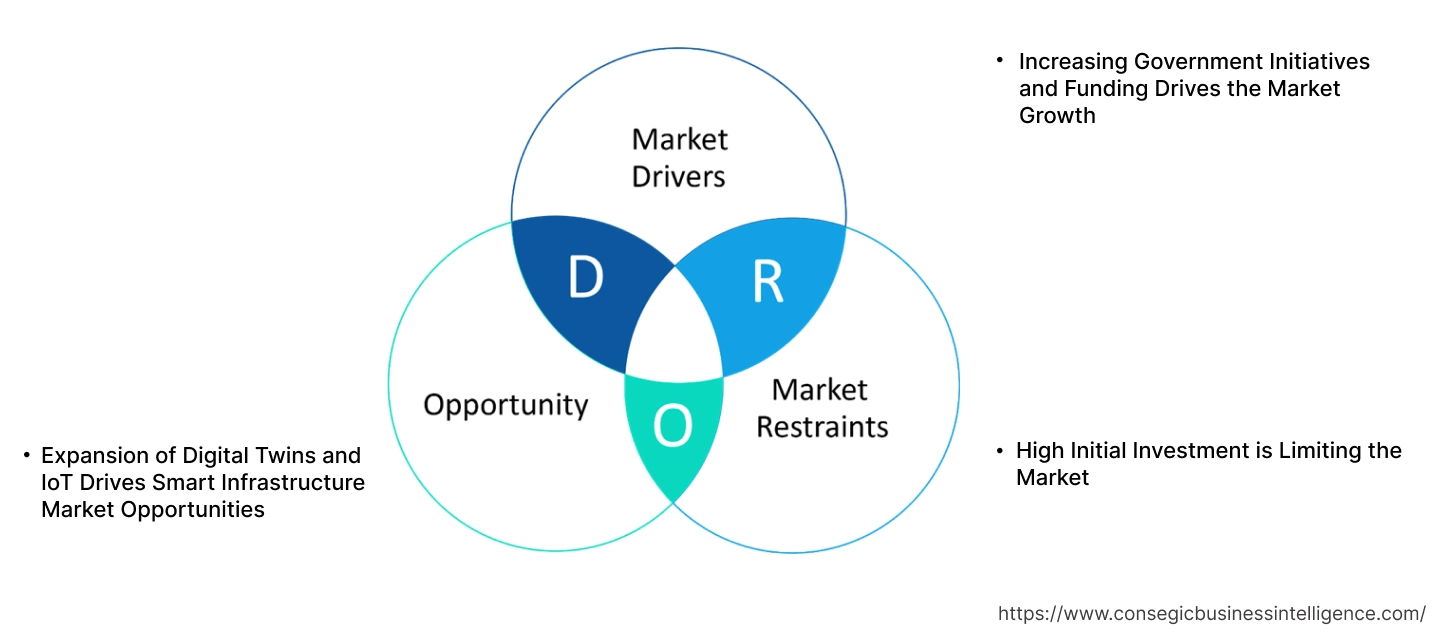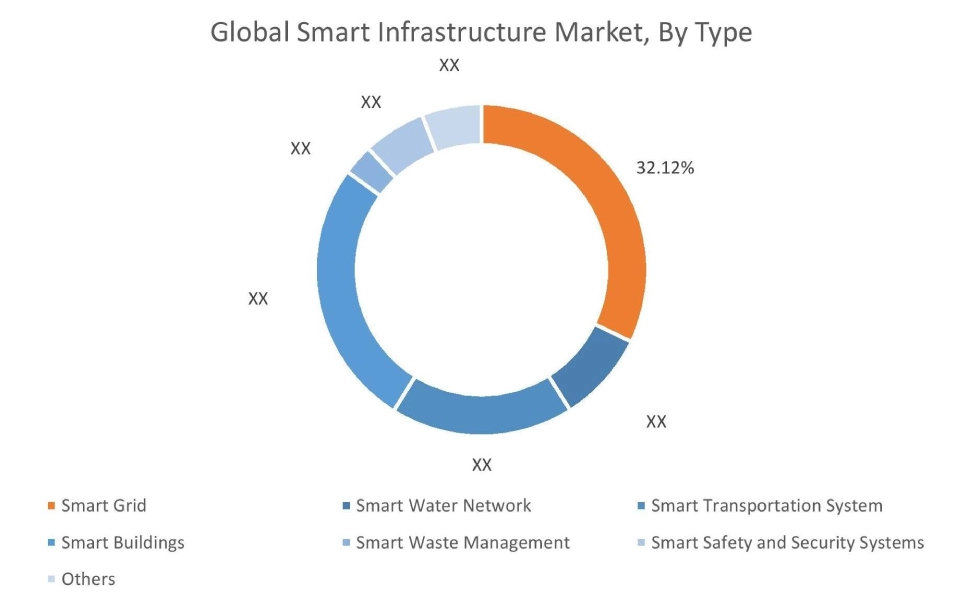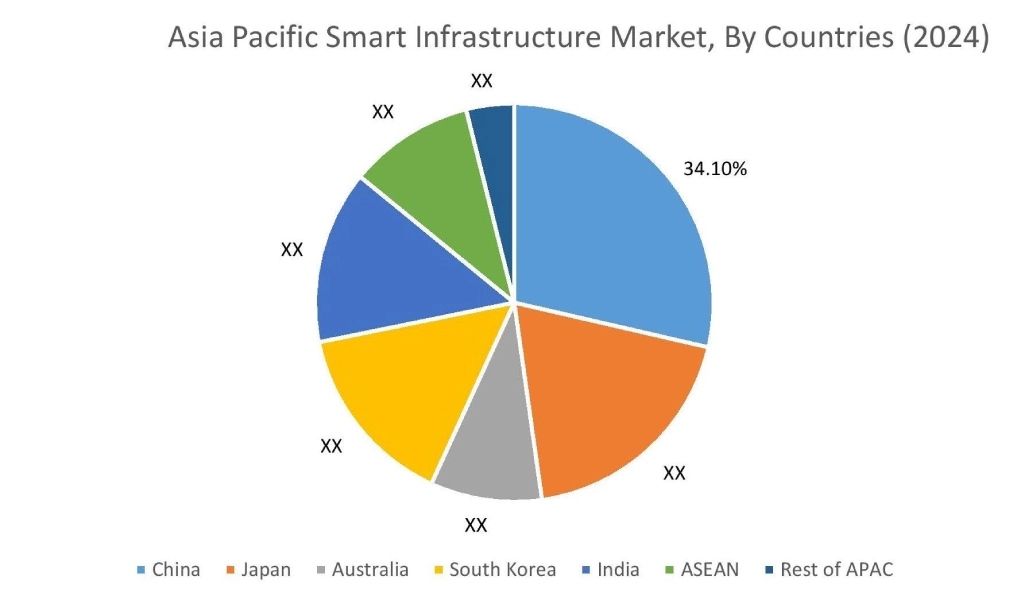Smart Infrastructure Market Size:
Smart Infrastructure Market is estimated to reach over USD 1,662.96 Billion by 2032 from a value of USD 448.13 Billion in 2024 and is projected to grow by USD 522.73 Billion in 2025, growing at a CAGR of 20.4% from 2025 to 2032.
Smart Infrastructure Market Scope & Overview:
Smart infrastructure refers to the use of advanced digital technologies to improve the efficiency, sustainability, and resilience of physical infrastructure assets. It involves a network of sensors, data, and interconnected systems that monitor, analyze, and automate critical functions in real-time, enabling proactive decision-making and optimal resource management. Further, key trends driving the smart infrastructure include rapid advancement and integration of technologies like AI, IoT, and 5G, which enable real-time data collection and automation. Furthermore, increasing global focus on sustainability and decarbonization is pushing governments and organizations to adopt smart solutions that improve energy efficiency and resource management.
How is AI Impacting the Smart Infrastructure Market?
AI is reshaping the market by transitioning it from a reactive to a proactive model. By analyzing vast amounts of data collected from IoT sensors, AI algorithms enable predictive maintenance, allowing operators to anticipate and fix potential equipment failures before they occur. This in turn reduces downtime and maintenance costs. Further, AI-powered systems are optimizing operational efficiency in real-time, such as dynamically adjusting traffic signals to ease congestion or balancing energy supply and demand on smart grids to prevent outages. This intelligence makes infrastructure more resilient, sustainable, and responsive to the needs of modern cities.
Smart Infrastructure Market Dynamics - (DRO) :
Key Drivers:
Increasing Government Initiatives and Funding Drives the Market Growth
Government initiatives and substantial public funding are a primary force behind the smart infrastructure market's growth. By launching national smart city programs and committing significant budgets, governments create a stable and long-term demand for smart solutions in areas like energy, transportation, and public safety. This financial support and policy guidance not only de-risk large-scale projects, making them more attractive to private investment, but also establish clear frameworks that encourage technology adoption and innovation. This in turn accelerates market maturity and provides the necessary momentum to overcome initial barriers and drive widespread deployment.
- For instance, in 2017, Saudi Arabia launched NEOM project in northwest Saudi Arabia to create a futuristic city powered entirely by renewable energy and it is a part of Saudi Vision 2030 to promote exceptional livability and groundbreaking conservation.
Thus, government initiatives and public funding are a major catalyst and are significantly contributing to the growth of smart infrastructure market size.

Key Restraints :
High Initial Investment is Limiting the Market
The high initial capital expenditure required for smart infrastructure projects is a significant barrier to market growth. The substantial upfront costs for advanced sensors, communication networks, and data management software can deter potential investors and government bodies, particularly in developing economies or smaller municipalities with limited budgets. This financial hurdle makes it difficult for many organizations to adopt digital transformation, even when recognizing the long-term benefits of improved efficiency, sustainability, and resilience. As a result, projects are often delayed, hindering the market's full potential.
Future Opportunities :
Expansion of Digital Twins and IoT Drives Smart Infrastructure Market Opportunities
The convergence of digital twins and IoT is creating significant opportunities in the smart infrastructure market by enabling a higher level of operational intelligence. IoT sensors, acting as the nervous system, collect vast amounts of real-time data on assets like bridges, traffic lights, and utility grids. This data is then fed into a digital twin, which serves as a living, virtual replica of the physical infrastructure. This synergy allows operators to perform real-time monitoring in a risk-free virtual environment and use predictive maintenance to anticipate failures before they occur. This proactive approach significantly improves efficiency, reduces costs, and enhances the resilience and safety of critical infrastructure.
- For instance, Siemens AG offers digital twin solution called Siemens Advanta, which is a bridge between the physical and digital worlds for infrastructure like buildings, campuses, and cities.
Thus, the convergence of digital twins and IoT empowers a proactive approach to smart infrastructure management, enhancing efficiency, safety, and resilience which in turn drives the smart infrastructure market opportunities.
Smart Infrastructure Market Segmental Analysis :
By Offering:
Based on the offering, the market is segmented into solutions and services.
Trends in the Offering:
- Solutions are being developed with a strong emphasis on energy efficiency, renewable energy integration, and reducing environmental impact which in turn drives the smart infrastructure market trends.
- Services are offering advanced solutions that use AI to predict failures, optimize resource allocation, and improve overall system performance which is expected to drive smart infrastructure market size.
Solutions accounted for the largest revenue share in the year 2024.
- Smart devices are increasingly integrating AI and machine learning at the edge, enabling real-time, autonomous decision-making in turn driving the smart infrastructure market share.
- Further, solutions are creating virtual replicas of physical infrastructure to simulate, monitor, and optimize performance before and after deployment.
- Furthermore, rollout of 5G provides the high speed and low latency necessary for real-time applications like autonomous vehicles and large-scale IoT deployments which in turn drives the smart infrastructure market trends.
- Thus, as per analysis, IoT convergence, digital twins, and 5G are driving the smart infrastructure market growth.
Services is anticipated to register the fastest CAGR during the forecast period.
- Service providers are shifting to subscription-based models, lowering upfront costs and making smart infrastructure solutions more accessible.
- Further, there is a growing demand for specialized services to protect critical infrastructure from sophisticated cyber threats and ensure data privacy which in turn propels the smart infrastructure market expansion.
- Therefore, based on analysis, "as-a-service" models and increased demand for cybersecurity are anticipated to boost the market growth during the forecast period.
By Type:
Based on the type, the market is segmented into smart grid, smart water network, smart transportation system, smart buildings, smart waste management, smart safety and security systems, and others.
Trends in the Type:
- Smart water networks are incorporating sensors to monitor water quality in real-time, ensuring public health and safety which in turn drives the smart infrastructure market demand.
- Increasing trend of connected and autonomous vehicles and intelligent traffic management drives the smart infrastructure market share.
Smart Grid accounted for the largest revenue share of 32.12% in the year 2024.
- Smart grid is increasingly focused on integrating intermittent renewable energy sources like solar and wind power to ensure grid stability and efficiency.
- Further, growing investment in Electric Vehicle (EV) charging infrastructure drives the smart infrastructure industry.
- Furthermore, increasing integration of AI and data analytics to monitor grid health in real-time and predict equipment failures, drives the smart infrastructure market demand.
- For instance, according to IEA, China is set to invest USD 442 billion between 2021 and 2025 to modernize and expand its power grids which is expected to drive the market.
- Thus, as per smart infrastructure market analysis, aforementioned factors are driving the smart infrastructure market growth.
Smart waste management is anticipated to register the fastest CAGR during the forecast period.
- Growing trend of adoption of smart bins equipped with fill-level sensors is a key factor driving the smart waste management
- Further, increasing integration of circular economy principles which promotes better waste segregation drives the smart infrastructure market expansion.
- Furthermore, use of digital platforms for tracking waste from collection to disposal is increasing, which in turn drives the market.
- Therefore, based on analysis, smart bins with IoT sensors, focus on circular economy, and digital waste tracking are anticipated to boost the market during the forecast period.

By End User:
Based on the end user, the market is segmented into non-residential and residential.
Trends in the End User:
- Homeowners are adopting smart solutions that integrate with solar panels and battery storage to monitor and optimize their energy use, which in turn drives the smart infrastructure market.
- Increasing adoption of integrated smart security systems for a comprehensive security drives the market.
Non-residential accounted for the largest revenue share in the year 2024 and is anticipated to register the fastest CAGR during the forecast period.
- Non-residential buildings are increasingly using AI and machine learning to optimize operations which in turn drive the market.
- Further, deployment of 5G networks in commercial and industrial settings is enabling a massive number of interconnected IoT devices to function seamlessly in turn boosting the market.
- Furthermore, there is an increasing trend of digital twin adoption and rising focus on sustainability which in turn spurs the market growth.
- Therefore, as per smart infrastructure market analysis, AI-powered building automation and integration of 5G and IoT are anticipated to boost the market during the forecast period.
Regional Analysis:
The regions covered are North America, Europe, Asia Pacific, Middle East and Africa, and Latin America.

Asia Pacific region was valued at USD 126.14 Billion in 2024. Moreover, it is projected to grow by USD 147.25 Billion in 2025 and reach over USD 472.28 Billion by 2032. Out of this, China accounted for the maximum revenue share of 34.10%. The market for smart infrastructure is mainly driven by rapid and unprecedented urbanization, which is straining existing resources and creating a pressing need for efficient urban management. Additionally, strong government support is accelerating the adoption of technology across various sectors.
- For instance, according to IEA, in 2022, India introduced a scheme worth approximately USD 38 billion to strengthen power distribution companies and enhance the country's electricity distribution infrastructure. The growing focus on smart grids is expected to drive the market.

North America is estimated to reach over USD 554.93 Billion by 2032 from a value of USD 149.24 Billion in 2024 and is projected to grow by USD 174.11 Billion in 2025. The North American market is primarily driven by the need to modernize and upgrade aging infrastructure, particularly in the smart grid and transportation sectors.
- Honeywell and Accelerator partnered to launch the Honeywell Smart City Accelerator Program. The initiative provides in-kind support to five U.S. cities including Cleveland, Louisville, Kansas City, San Diego, and Waterloo. The program aims to help these cities secure funding for transformational projects that will enhance residents' quality of life in areas such as sustainability, public safety, and operational efficiency.
The regional analysis depicts that strong focus on sustainability and green initiatives, along with supportive government policies and significant investments in Europe are driving the market. Additionally, factors driving the market in the Middle East and African region are megaprojects like smart city and a strong push for economic diversification. Further, increasing urbanization and a strong focus on improving transportation across the region is paving the way for the progress of market trends in Latin America region.
Top Key Players & Market Share Insights:
The global smart infrastructure market is highly competitive with major players providing solutions to the national and international markets. Key players are adopting several strategies in research and development (R&D), product innovation, and end-user launches to hold a strong position in the smart infrastructure industry. Key players in the global smart infrastructure market include-
- Siemens AG (Germany)
- Huawei (China)
- Itron (US)
- Topcon (Japan)
- Xylem Inc. (US)
- Wipro (India)
- Honeywell International Inc. (US)
- IBM Corporation (US)
- Cisco (US)
- Schneider Electric (France)
- ABB (Switzerland)
Recent Industry Developments :
- In January 2025, MIRAIT ONE Corporation launched a cloud-based "Smart Water Meter Remote Monitoring System" designed for water-supply businesses. The new system aims to enhance the efficiency of operations, maintenance, and management of industrial water by offering remote monitoring, faster response to problems, and vendor-free compatibility with various flow meters.
Smart Infrastructure Market Report Insights :
| Report Attributes | Report Details |
| Study Timeline | 2019-2032 |
| Market Size in 2032 | USD 1,662.96 Billion |
| CAGR (2025-2032) | 20.4% |
| By Offering |
|
| By Type |
|
| By End User |
|
| By Region |
|
| Key Players |
|
| North America | U.S. Canada Mexico |
| Europe | U.K. Germany France Spain Italy Russia Benelux Rest of Europe |
| APAC | China South Korea Japan India Australia ASEAN Rest of Asia-Pacific |
| Middle East and Africa | GCC Turkey South Africa Rest of MEA |
| LATAM | Brazil Argentina Chile Rest of LATAM |
| Report Coverage |
|
Key Questions Answered in the Report
How big is the smart infrastructure market? +
The smart infrastructure market is estimated to reach over USD 1,662.96 Billion by 2032 from a value of USD 448.13 Billion in 2024 and is projected to grow by USD 522.73 Billion in 2025, growing at a CAGR of 20.4% from 2025 to 2032.
What specific segmentation details are covered in the smart infrastructure report? +
The smart infrastructure report includes specific segmentation details for offering, type, end user, and regions.
Which is the fastest segment anticipated to impact the market growth? +
In the smart infrastructure market, smart waste management is the fastest-growing segment during the forecast period.
Who are the major players in the Smart Infrastructure market? +
The key participants in the smart infrastructure market are Siemens AG (Germany), Wipro (India), Honeywell International Inc. (US), IBM Corporation (US), Cisco (US), Schneider Electric (France), ABB (Switzerland), Huawei (China), Itron (US), Topcon (Japan), Xylem Inc. (US), and others.
What are the key trends in the smart infrastructure market? +
The smart infrastructure market is being shaped by several key trends including rapid advancement and integration of technologies like AI, IoT, and 5G, which enable real-time data collection and automation.

